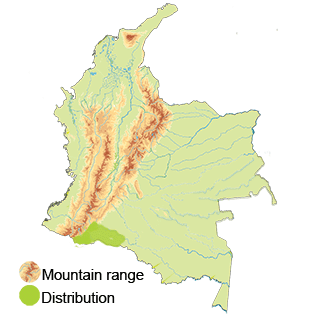Saphire Quail-dove
The Saphire Quail-dove (Geotrygon saphirina). Read in Spanish
Appearance: The Saphire Quail-dove is a medium-sized bird with a striking blue-violet plumage on its upperparts, giving it a vibrant appearance, while its underparts are a paler gray color. This species has a short tail, a rounded body shape, and a distinctive red eye ring, which adds to its beautiful and unique appearance.
Habitat:
The Saphire Quail-dove is typically found in mountainous forests, cloud forests, and subtropical or tropical moist montane forests at altitudes ranging from 1,000 to 2,500 meters in the Colombian Andes.
Behavior: This bird is known to be secretive and elusive, often foraging on the forest floor for seeds, fruits, and insects. It tends to stay hidden in dense vegetation, making it challenging to spot in the wild.
Breeding: The breeding habits of the Saphire Quail-dove are not extensively documented. Like other doves and pigeons, they likely form monogamous pairs and build simple nests on trees or shrubs.
Conservation Status: The Saphire Quail-dove is classified as Near Threatened (NT) on the IUCN Red List. It faces threats primarily from habitat loss due to deforestation for agriculture, logging, and human settlements.
Distribution
The Saphire Quail-dove, endemic to Colombia, is primarily found in the Southern Andes mountain range within the country.
Southern Andes: The Southern Andes, incorporating regions like Nariño and Putumayo departments, also provide potential habitats for the Saphire Quail-dove, especially in the higher elevations where suitable forest cover and food sources are available.
Taxonomy
The Saphire Quail-dove (Geotrygon saphirina)
- Kingdom: Animalia
- Phylum: Chordata
- Class: Aves (Birds)
- Order: Columbiformes
- Family: Columbidae
- Genus: Geotrygon
- Species: Geotrygon saphirina
Vocalization
The Saphire Quail-dove (Geotrygon saphirina)
- Song: The Saphire Quail-dove's song is typically described as a series of low, mournful coos or hoots. These calls are often soft and melodic, with a pleasing quality to human ears. The vocalizations are usually repetitive and can carry through the dense vegetation of its forest habitat, allowing individuals to communicate over distances.
- Call: In addition to its song, the Saphire Quail-dove emits a variety of calls for different purposes, such as maintaining contact with its mate, signaling alarm, or establishing territory. Calls of the Saphire Quail-dove can vary in tone and intensity, sometimes sounding more urgent or assertive depending on the context.
- Courtship: During courtship displays, the Saphire Quail-dove may produce specific vocalizations that are part of its mating rituals. These sounds can be part of elaborate displays to attract a mate or reinforce pair bonds.
- Duetting: Some bird species engage in duetting, where males and females sing together in synchronized patterns. While information on duetting behavior in the Saphire Quail-dove specifically is limited, duetting is common in some dove species and could be present in this species as well.




